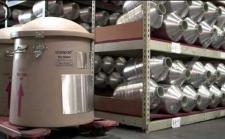Inside the Hidden Global Supply Chain for Frozen Sperm, Eggs, and Embryos
By Sarah Zhang,
WIRED
| 04. 25. 2016
Untitled Document
In a world with porous borders and wildly divergent surrogacy laws, making a baby can be a global affair: The eggs might come from a woman in South Africa, the sperm from a man in Canada, and the surrogate herself might be in Cambodia. What connects them, literally, is a cold chain.
Typical cold chains—made up of refrigerated trucks and shipping containers—bring us perfectly preserved bananas from Central America, seafood from Asia, and vaccines from Europe. But it takes a specialized cold chain to transport finicky eggs, sperm, and embryos across the world for surrogacy via in vitro fertilization. To expectant parents, that material is more precious any other possible cargo. And they’re willing to pay. A lot.
Continue reading on WIRED...
Image via Cyroport
Related Articles
By Grace Won, KQED [with CGS' Katie Hasson] | 12.02.2025
In the U.S., it’s illegal to edit genes in human embryos with the intention of creating a genetically engineered baby. But according to the Wall Street Journal, Bay Area startups are focused on just that. It wouldn’t be the first...
Several recent Biopolitical Times posts (1, 2, 3, 4) have called attention to the alarmingly rapid commercialization of “designer baby” technologies: polygenic embryo screening (especially its use to purportedly screen for traits like intelligence), in vitro gametogenesis (lab-made eggs and sperm), and heritable genome editing (also termed embryo editing or reproductive gene editing). Those three, together with artificial wombs, have been dubbed the “Gattaca stack” by Brian Armstrong, CEO of the cryptocurrency company...
By Lucy Tu, The Guardian | 11.05.2025
Beth Schafer lay in a hospital bed, bracing for the birth of her son. The first contractions rippled through her body before she felt remotely ready. She knew, with a mother’s pit-of-the-stomach intuition, that her baby was not ready either...
By Emily Glazer, Katherine Long, Amy Dockser Marcus, The Wall Street Journal | 11.08.2025
For months, a small company in San Francisco has been pursuing a secretive project: the birth of a genetically engineered baby.
Backed by OpenAI chief executive Sam Altman and his husband, along with Coinbase co-founder and CEO Brian Armstrong, the startup—called...




